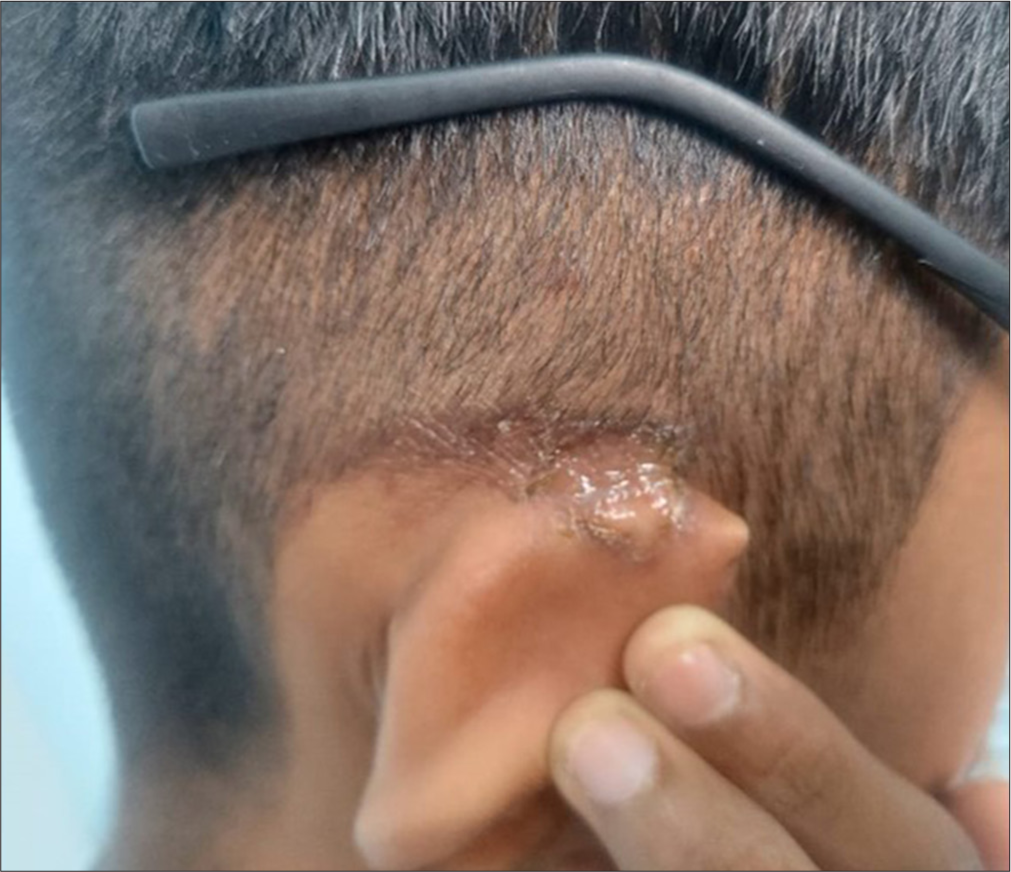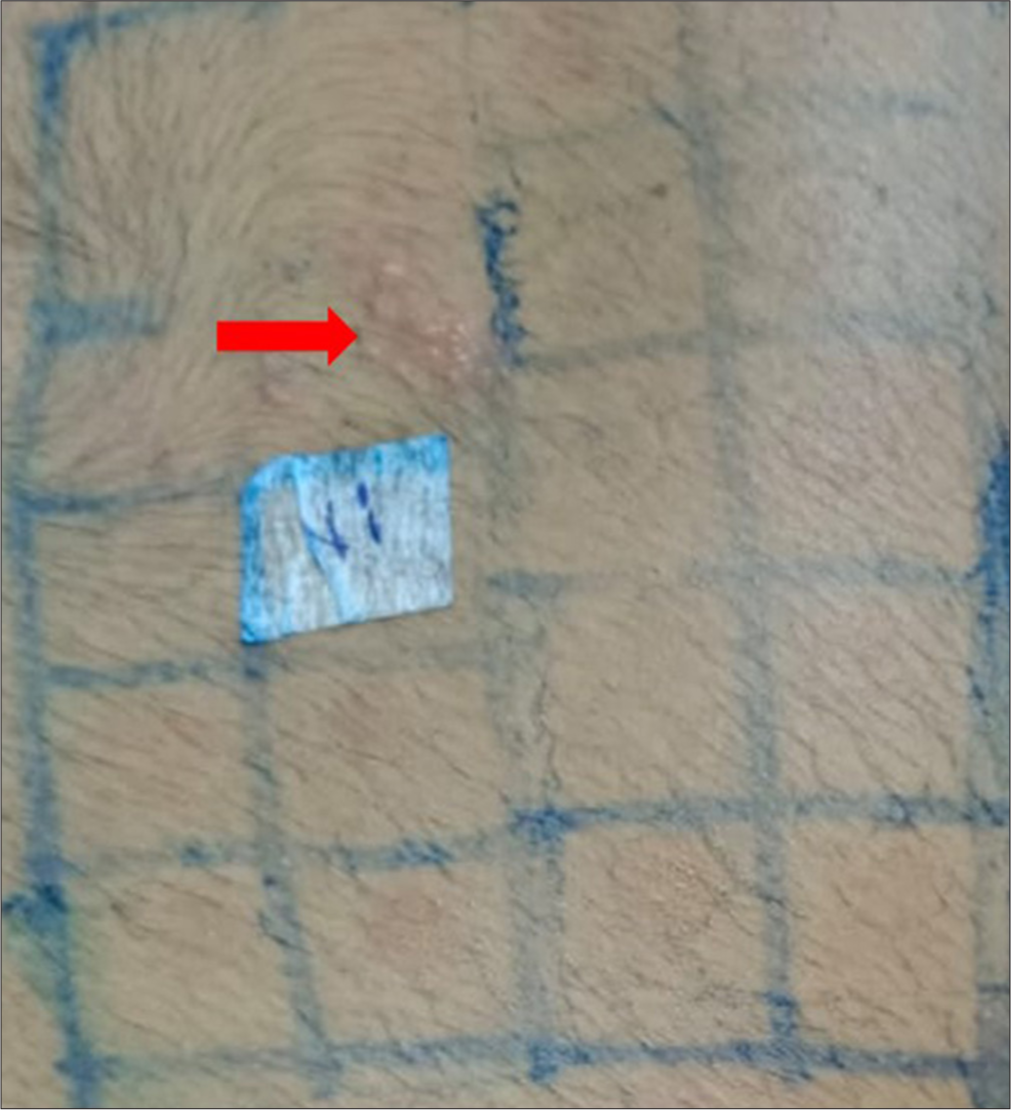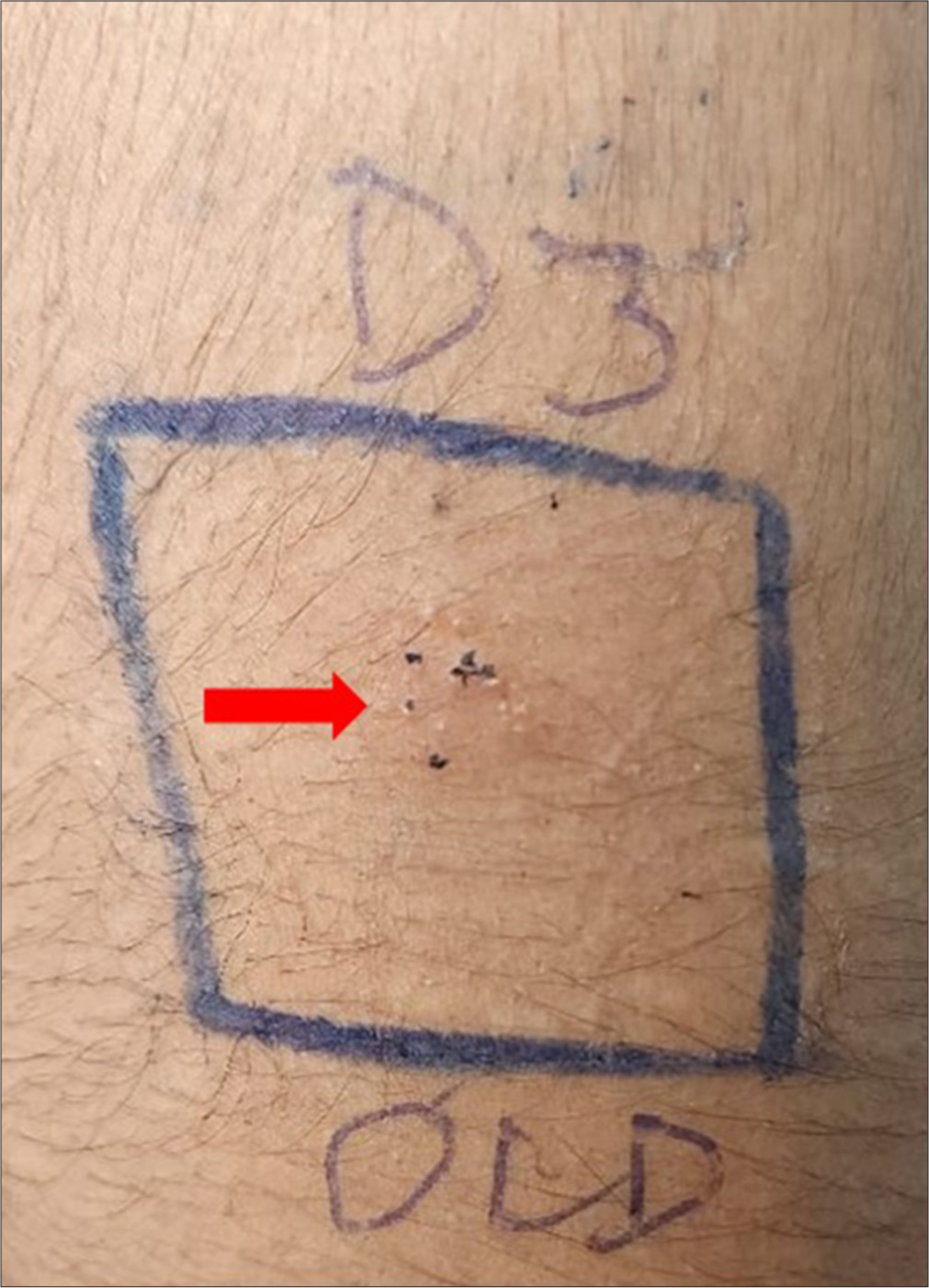Translate this page into:
Sensitivity to nickel, cobalt, and plastic in spectacles
*Corresponding author: Nithya Satish, Department of Dermatology, Ranga’s Centre of Dermatology, Coimbatore, Tamil Nadu, India. hamlet.nithya@gmail.com
-
Received: ,
Accepted: ,
How to cite this article: Satish N, Srinivas CR, Lal S. Sensitivity to nickel, cobalt, and plastic in spectacles. Indian J Skin Allergy. 2025;4:75-7. doi: 10.25259/IJSA_53_2024
Abstract
Allergic contact dermatitis (ACD) to spectacle frames is sparsely reported. Potential allergens causing ACD are metals, plastics, plasticizers, antioxidants, rubber, waxes, solvents, and dyes. Of these, nickel and chromium are most frequently reported. Fine scratches in the eyeglass frames may trigger the release of allergen which can induce ACD. We report a case of a boy who developed ACD to spectacle frames.
Keywords
Allergic contact dermatitis
Cobalt sulfate
Nickel sulfate
Plastics
Spectacles
INTRODUCTION
Allergic contact dermatitis (ACD) is a common problem, and diagnosing the condition can be challenging. Diagnosis is by careful history and meticulous examination followed by patch testing. Here, we report a case of ACD to spectacles in a boy. In addition, we are highlighting the importance of patch testing with patients’ material to confirm the diagnosis and highlight the possibility of wrong conclusions following such testing due to the intermixing of one antigen with another.
CASE REPORT
An 18-year-old boy presented with bilateral lesions showing oozing and crusting over the area of the ear located between the pinna and the temple for 3 months. He had used topical steroids with antibiotics with partial remission followed by relapse. ACD was suspected since the affected site corresponded to the area in contact with the temple of the spectacle [Figure 1]. The patient was wearing the incriminated eyeglasses for 1 year. The spectacles were made of plastic, and a metal support could be seen in the stem of the temple of the spectacles. Patch test by standard method with Indian Standard Series obtained from Systopic Laboratories was performed and interpreted as recommended by International Contact Dermatitis Research Group. In addition, we tested him with scraping obtained from the part of the spectacle frame in contact with the skin. He tested positive for nickel sulfate [Figure 2], cobalt sulfate, and spectacle scrapings. We then considered the possibility of contamination of the scraping by the seepage of nickel into the frame, and so the patch test with scrapings from a new frame, like the one which the patient was using, and the old after 1 week and both showed positive reaction [Figure 3]. A topical corticosteroid was given for the lesion. The patient was advised to change the spectacle every year. Furthermore, the patient was advised to take good care of the eyeglasses since scratches and breaks to the frame of the spectacles can lead to seepage of allergens to the skin. The patient was advised to use a stainless-steel frame or titanium frame with a nickel-free coating. After changing the spectacles, the patient was free of lesions during the 4-month follow-up.

- 18-year-old boy with oozing and crusting bilaterally over the area of the ear located between the pinna and the temple which corresponds to the area in contact with the temple of the spectacle.

- Positive reaction to nickel sulfate (red arrow).

- Positive reaction to old spectacle frame (red arrow).
DISCUSSION
ACD is a common skin disorder clinically presenting with itching, erythema, and edema of the skin. Various causative allergens reported are nickel, chromium, preservatives, and fragrances.[1] Of these, nickel is a common allergen causing eyeglass ACD.[2] It is present in watches, trouser buttons, and metallic spectacle frames.[3] The other allergens that can cause ACD to spectacles include plastic solvents SO60, SY14, and ethyl acetate.
Materials used for the manufacturing of commercially sold modern spectacle frames are metal, plastic, or composites (a combination of the two).[4] Manufacturers choose the materials based on their cost-effectiveness, workability, safety, easily adjustable, and ability to resist heat, breakage, and corrosion. Hence, allergens from eyeglass frames have metals, solvents, plastics, plasticizers, ultraviolet stabilizers, waxes, dyes, antioxidants, and others.[5]
Different types of metals used in the spectacle frames are nickel, chromium, copper, titanium, cobalt, gold, silver, platinum, palladium, aluminum, and alloys. Of these metals, nickel and chromium are most frequently used and reported as the cause of ACD, and the manufacturers state that metals with varying concentrations are present in the spectacle frames.[3] Nickel is commonly used in end pieces, the inner core of temples, heavy bridges, and hinges.[4] In its pure form, nickel is scarcely used in the spectacle frames except as a plating material to increase the bond between the main frame and the outer layer.[3] Patients with ACD to nickel sometimes report higher allergic reactions to chromium.[3]
In the spectacle, the frame is the common source of allergen-causing ACD. The surface of the plating has microscopic imperfections, and when dissolved in sweat, nickel gets released from nickel-plated materials.[3] These tiny scratches damaging the plated frames are easily seen in the spectacle frames. It can be hypothesized that through these fine scratches, nickel and chromium may easily induce ACD.[3] In a study conducted by Kim et al., the fine scratches were more severe on the skin-contacting surface of the spectacle frames compared to non-skin-contacting parts.[3] Physical factors such as rubbing, scratches, maceration, and pressure also might play a role in inducing ACD.
Suspecting ACD and confirming the sensitivity to suspected allergens are time-consuming and require effort on the part of the physician and patient, but can be satisfying, and patients are often pleased when the cause can be identified and eliminated, more so when the allergy has been causing inconvenience for a prolonged duration. It is recommended to change the eyeglasses every 2 years.[3] However, our patient developed ACD to spectacle within 1 year. Therefore, we advised to change the eyeglasses every 1 year.
Allergy to metals is quite common but allergy to plastic is less reported. Apart from allergy, depigmentation following contact with phthalates in the plastic earpiece of the stethoscope is reported.[6]
CONCLUSION
The spectacle frame, which is unlikely to cause an allergic reaction in the patient, can be recommended. We also highlight the possibility of the presence of the allergen seeping into the scrapped material, inducing a positive reaction. In addition, we are highlighting the importance of patch testing with patients’ material to confirm the diagnosis and highlight the possibility of wrong conclusions following such testing due to the intermixing of one antigen with another.
Ethical approval
Institutional Review Board approval is not required.
Declaration of patient consent
The authors certify that they have obtained all appropriate patient consent.
Conflicts of interest
There are no conflicts of interest.
Use of artificial intelligence (AI)-assisted technology for manuscript preparation
The authors confirm that there was no use of artificial intelligence (AI)-assisted technology for assisting in the writing or editing of the manuscript and no images were manipulated using AI.
Financial support and sponsorship: Nil.
References
- Contact dermatitis caused by nickel release from hair clasps purchased in a country covered by the EU Nickel Directive. Contact Dermatitis. 2009;60:180-1.
- [CrossRef] [PubMed] [Google Scholar]
- Triphenyl phosphate allergy from spectacle frames. Contact Dermatitis. 1986;15:274-7.
- [CrossRef] [PubMed] [Google Scholar]
- The fine scratches of the spectacle frames and the allergic contact dermatitis. Ann Dermatol. 2013;25:152-5.
- [CrossRef] [PubMed] [Google Scholar]
- Dermatological aspects of contact dermatitis from eyeglass frames and optical materials. Coll Antropol. 2013;37:19-24.
- [Google Scholar]
- Eyeglass frame allergic contact dermatitis: Does tacrolimus prevent recurrences? Contact Dermatitis. 2005;53:219-21.
- [CrossRef] [PubMed] [Google Scholar]
- Stethoscope earpiece-induced chemical depigmentation. Contact Dermatitis. 2003;49:110-1.
- [CrossRef] [PubMed] [Google Scholar]






